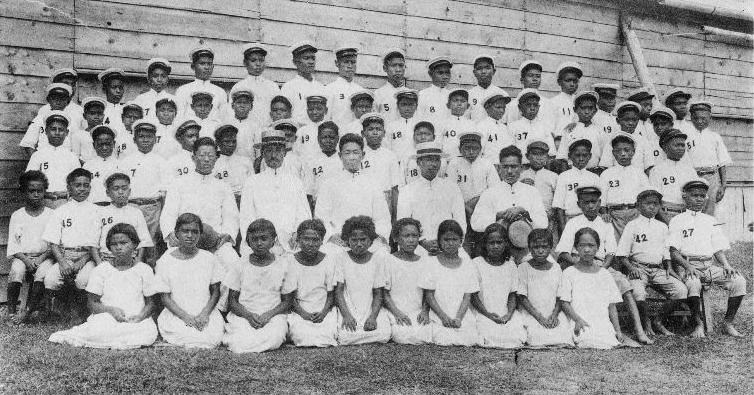
Micronesian History: Japanese League of Nations Mandate

Figure 1.--This image shows a Japanese school on Yap. It come from a Japanese book published in the late-1920s. This photograph was apparently taken furing the German era, probably a mission school. The Germans did not, have public schools, but there were some mission schools. The book had a propaganda goal, to show the public works that Japan had been able to carry out. Note that there seem to be both Yapese and Japanese children at the school. Interesting that there seem to be both Yap and Japanese children together. I'd guess that these were families that wee closely working with the Japanese. We wonder just how many Yapese children attended the Japanese schools. Looking at the photo we can also ask how these children could own school uniforms when in everyday life at most Yapese children wore loincloths.
|
|
Japanese merchants even before World War I had a presence in Micronesia, especially at Chuuk. Some in Japan thus saw the central Pacific as a natural adition to the Japanese Empire. The League of Nations after World War I granted Japan a mandate over the Carolines (1920). Japan began its formal administration od the islands when the Imperial Navy trnsferred reponsibility to civilian administrators (1920). Japanese economic activity in the central Pacific began (late-19th century). The Nan’yo Boeki Kaisha (South Seas Trading Company--NBK) ws set up to coordinate activity (1908). One the Japanese seized control, NBK gained a monopoly over copra production and trade throughout the central Pacific mandated islands. Shipping between the islands and Japan was controlled by the Nippon Yusen Kaisha (Japan Mail Steamship Company). The Japanese government also played a role in operating phosphate mines on Angaur in Palau, and supported a wide range of other economic development activities. The Nan’yo Takushoku, (South Seas Colonization Corporation-KK) was formed to promote Japanese colonization and settlement of the Mandated islands and economic development. The Japanese made investments to improve the islands' infrastructure. This included opening public schools. The Japanese promote migration and large numbers of Japanese settled in the cebntralmPacific. The largest Japanese settlement was in the Marianas, especially Saipan. One source reports a Japanese population of more than a 100,000 throughout their central Pacific islands. This outnumbered the indigenous eople who numbered about 40,000 people. The Japanese diversified the econmy of the island to including tropical agriculture especially sugar cane, mining, and fisheries. The sugar industry ws primarily on the Marianas. Yap became an important communications center. Among the most profitable of the new industries was fisheries. Both NBK and NKK put large fleets of fishing boats to sea, and ran substantial fish processing plants on many islands. [King] As part of the League of Nations Mandate, the Japanese were susposed to permit free trade and were prohibited from fortifying the islands. Japanese policy clearly violated the commitment to free trade. The military facility violations were less clear. As part of the Japanese economic development of the islands, a great deal of infrastructure was built, including ports, airfields, and raillines. These facilities seem to have been primarily part of economic development, but had obvious military uses as well. Japan invaded Manchuria (1931). In response the League censured Japan. The Japanse simoly withdrew from the League. The League had no way of taking back control of the Mandates and the great powers had no invlination to challenging Japan in a meaningful way on the mater. Thus the League mandate obligations no longer held any sway. And Japan also refused to renew the Washington Naval Treary limits. The United States became increasingly concerned about Japanese activities on the islands as tensions increased after Japan invaded China proper (1937). The Japanese turned Truk into one of the greatest military complexes in the Pacific. We are not yet sure, h0wever, just when the military facilities were built. We believe it was pimarily after the Japanese withdrew from the League.
Sources
King, Thomas F. "The Islands of the Japanese Mandate in 1937," The Earhart Project,
by Ph.D.
HBC

Navigate the Boys' Historical Clothing Web Site:
[Return to the Main Micronesian history page]
[Return to the Main Micronesia page]
[Return to the Main Oceania page]
[Return to the Main countries page]
[Introduction]
[Activities]
[Biographies]
[Chronology]
[Cloth and textiles]
[Clothing styles]
[Countries]
[Topics]
[Bibliographies]
[Contributions]
[FAQs]
[Glossaries]
[Images]
[Links]
[Registration]
[Tools]
[Boys' Clothing Home]
Created: 9:12 PM 3/5/2012
Last updated: 1:10 AM 1/10/2014



